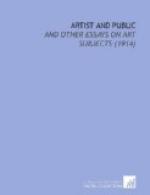Altogether too much, for instance, has been made of the fact that Millet was born a peasant. He was so, but so were half the artists and poets who come up to Paris and fill the schools and the cafes of the student quarters. To any one who has known these young rapins, and wondered at the grave and distinguished members of the Institute into which many of them have afterward developed, it is evident that this studious youth—who read Virgil in the original and Homer and Shakespeare and Goethe in translations—probably had a much more cultivated mind and a much sounder education than most of his fellow students under Delaroche. Seven years after this Norman farmer’s son came to Paris, with a pension of 600 francs voted by the town council of Cherbourg, the son of a Breton sabot-maker followed him there with a precisely similar pension voted by the town council of Roche-sur-Yon; and the pupil of Langlois had had at least equal opportunities with the pupil of Sartoris. Both cases were entirely typical of French methods of encouraging the fine arts, and the peasant origin of Millet is precisely as significant as the peasant origin of Baudry.
[Illustration: Plate 2.—Millet. “The Sower.” In the Metropolitan Museum of Art. Vanderbilt collection.]
Baudry persevered in the course marked out for him and, after failing three times, received the Prix de Rome and became the pensioner of the state. Millet took umbrage at Delaroche’s explanation that his support was already pledged to another candidate for the prize, and left the atelier of that master after little more than a year’s work. But that he had already acquired most of what was to be learned there is shown, if by nothing else, by the master’s promise to push him for the prize the year following. This was in 1838, and for a year or two longer Millet worked in the life classes of Suisse and Boudin without a master. His pension was first cut down and then withdrawn altogether, and he was thrown upon his own resources. His struggles and his poverty during the next few years were those of many a young artist, aggravated, in his case, by two imprudent marriages. But during all the time that he was painting portraits in Cherbourg or little nudes in Paris he was steadily gaining reputation and making friends. If we had not the pictures themselves to show us how able and how well-trained a workman he was, the story told us by Wyatt Eaton, in “Modern French Masters,” would convince us. It was in the last year of Millet’s life that he told the young American how, in his early days, a dealer would come to him for a picture and, “having nothing painted, he would offer the dealer a book and ask him to wait for a little while that he might add a few touches to the picture.” He would then go into his studio and take a fresh canvas, or a panel, and in two hours bring out a little nude figure, which he had painted during that time, and for which he would receive twenty or twenty-five francs. It was the work of this time that Diaz admired for its color and its “immortal flesh painting”; that caused Guichard, a pupil of Ingres, to tell his master that Millet was the finest draughtsman of the new school; that earned for its author the title of “master of the nude.”




